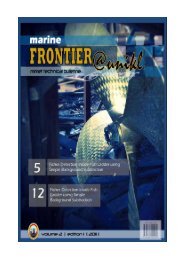click here to download - UniKL MIMET Official Website
click here to download - UniKL MIMET Official Website
click here to download - UniKL MIMET Official Website
You also want an ePaper? Increase the reach of your titles
YUMPU automatically turns print PDFs into web optimized ePapers that Google loves.
<strong>MIMET</strong> Technical Bulletin Volume 1 (2) 2010<br />
Feature Article 6<br />
DEVELOPMENT OF LEGAL FRAMEWORK GOVERNING THE CARRIAGE OF LIQUIFIED<br />
NATURAL GAS (LNG) WITHIN COASTAL WATER FROM CARRIER ASPECT<br />
(OPERATIONAL PROCEDURE)<br />
ASMAWI BIN ABDUL MALIK*<br />
Department of Marine Construction & Maintenance Technology<br />
Malaysian Institute of Marine Engineering Technology, Universiti Kuala Lumpur<br />
Received: 12 July 2010; Revised: 2 August 2010 ; Accepted: 18 August 2010<br />
ABSTRACT<br />
The inevitable LNG evolution in<strong>to</strong> coastal waters had reflected the lack and absence of clear guidelines on legal frame‐<br />
work for governing the carriage of liquefied natural gas (LNG) within coastal water. IMO (Agenda item 21, MSC 83/<br />
INF.3/2007) does not pay much attention <strong>to</strong> sustainable coastal water transport development due <strong>to</strong> the novelty of such<br />
industry and the traditional procedures of UN developmental bodies, that normally needs sufficient time <strong>to</strong> consider new<br />
and emerging phenomenon in their agenda of work. Thus it is a major source of inefficiency and unsafe operation of the<br />
LNG carriage along the coast line. To date, t<strong>here</strong> is no extension for LNG carriage within coastal waters on every estab‐<br />
lished rules and regulation. The main purpose of this study is <strong>to</strong> develop a legal framework model for the LNG transporta‐<br />
tion and carriage by using the IDEF0 structured modeling technique. The modeling process is divided in<strong>to</strong> three phases,<br />
(i) the information gathering, (ii) the model development and (ii) the experts’ evaluation and validation. In the first phase,<br />
information on existing current legal practices were obtained through the literature study from applicable rules, regula‐<br />
tions, conventions, procedures, policies, research papers and accident cases. In the second phase, a process model was<br />
drafted through an iterative process using the IDEF0 and the questionnaire is developed. From the questionnaire pilot<br />
test, each question blocks has shown an acceptable Cronbach’s Alpha value which is above 0.70. In the third phase, the<br />
preliminary of legal framework model is tested through forty five (45) potential respondents from various fields in legal<br />
practices and thirty eight (38) responded. A promising result was obtained w<strong>here</strong> data exhibit normal distribution trend,<br />
even though every group has their own stand on the legal framework. The ANOVA output has generated P‐values of<br />
0.000. If P is less than or equal <strong>to</strong> the a‐level, one or more mean value are significantly different. Through data correla‐<br />
tion test, the correlated element blocks show a range of 0.0 <strong>to</strong> 0.4. A legal framework model for the LNG carriage within<br />
coastal water was constructed in the stand alone mode covering each aspect.<br />
Keywords: Legal framework model, LNG carriage, structured modelling technique definition, Cronbach’s Alpha, ANOVA and Correlation.<br />
INTRODUCTION<br />
In tandem with the increasing Liquefied Natu‐<br />
ral Gas (LNG) production in the emerging mar‐<br />
ket, the LNG is depleting fast and will be re‐<br />
quired on a major scale <strong>to</strong> feed the world’s<br />
biggest gas market. T<strong>here</strong>fore, attention is<br />
needed <strong>to</strong> focus largely on the safety and secu‐<br />
rity of LNG transported by marine transporta‐<br />
tion at commercial facilities near populated<br />
areas. As the nation’s LNG facility become de‐<br />
veloped, t<strong>here</strong> is no special framework for the<br />
*Corresponding Author: Tel.: +605‐6909051<br />
Email address: asmawiam@mimet.unikl.edu.my<br />
LNG coastal transportation. In response <strong>to</strong> the<br />
overall safety and security environment re‐<br />
quirement, it is wise <strong>to</strong> seek a coastal water<br />
legal framework covering a broader under‐<br />
standing of hazardous chemical marine ship‐<br />
ments and efforts <strong>to</strong> secure them. Recognizing<br />
these fatal fac<strong>to</strong>rs is important in promoting<br />
for a legal framework for LNG transportation in<br />
coastal water.<br />
| MARINE FRONTIER @ <strong>UniKL</strong><br />
74



